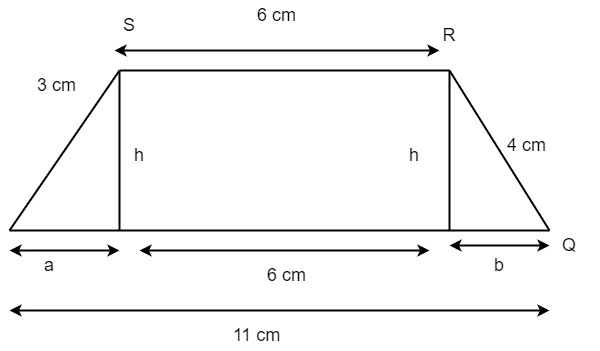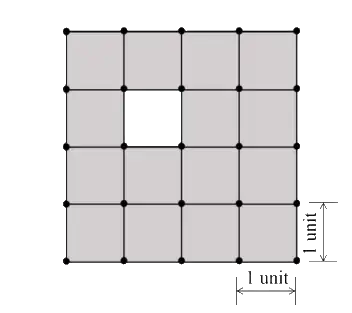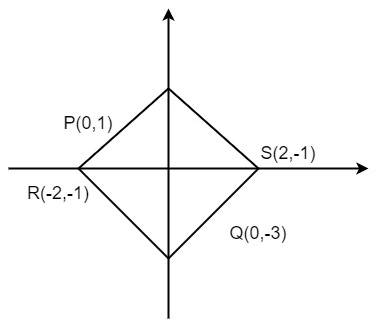Questions 1 to 10 Solutions
Q.1 – Q.5 Carry ONE mark each.
Q.1 Mr. X speaks _______ Japanese ______ Chinese.
(A) neither / or
(B) either / nor
(C) neither / nor
(D) also / but
Ans. c) neither / nor
Q.2 A sum of money is to be distributed among P, Q, R, and S in the proportion 5 : 2 : 4 : 3, respectively. If R gets ₹ 1000 more than S, what is the share of Q (in ₹)?
(A) 500
(B) 1000
(C) 1500
(D) 2000
Ans. (D) 2000
Solution: Let x be the proportion constant
Let P= 5x, Q=2x, R=4x, S= 3x
It is given that R gets Rs. 1000 more than S , So we get
R-S = 1000
4x-3x= 1000
x= 1000
Therefore, the share of Q is 2x= 2 x 1000 = Rs. 2000
The share of Q (in ₹) is Rs. 2000.
Q.3 A trapezium has vertices marked as P, Q, R and S (in that order anticlockwise). The side PQ is parallel to side SR.Further, it is given that, PQ = 11 cm, QR = 4 cm, RS = 6 cm and SP = 3 cm. What is the shortest distance between PQ and SR (in cm)?
(A) 1.80
(B) 2.40
(C) 4.20
(D) 5.76
Ans. (B) 2.40
Solution: From the given information the trapezium can be drawn as,

Let PQRS be the trapezium where h is the distance between parallel sides
a+b =11-6 = 5
Now, applying pythagoras theorem on both the end of trapezium
h2+a2=16 –(i)
Similarly on the other side it will be
h2+a2 = 9 –(ii)
Solving eq.(i) and (ii) simultaneously we get,
b2-a2 = 7
(b+a) (b-a) = 7
Putting values of a,b
5(b-a) = 7
So, (b-a) = 7/5 –(iii)
and b+a =5 –(iv)
Adding eq.(iii) and (iv)
2b = \frac{7}{5} +5 = \frac{32}{5}
b= \frac{16}{5}
From eq.(i) , putting value of b in eq. (i)
h^{2}=16-\left ( \frac{16}{5} \right )^{2}=16-\frac{256}{25}=\frac{400-256}{25}=\frac{144}{25}By solving we get,
h=2.4
Q.4 The figure shows a grid formed by a collection of unit squares. The unshaded unit square in the grid represents a hole. What is the maximum number of squares without a “hole in the interior” that can be formed within the 4 × 4 grid using the unit squares as building blocks?

(A) 15
(B) 20
(C) 21
(D) 26
Ans. (B) 20
Solution: The given figure is

Let h be the square without hole
R be the rows in a given square and C be the column in a given square
The no. of squares without hole is given by,
R x C – h = 16 – 1 = 15
So, 15 is (1 x 1 ) squares now caqlculating (2 x 2) squares
(2 x 2) = 5
So, Total number of squares = 15 + 5 = 20
Therefore, 20 squares can be formed within the 4x 4 grid.
Q.5 An art gallery engages a security guard to ensure that the items displayed are protected. The diagram below represents the plan of the gallery where the boundary walls are opaque. The location the security guard posted is identified such that all the inner space (shaded region in the plan) of the gallery is within the line of sight of the security guard. If the security guard does not move around the posted location and has a 360oview, which one of the following correctly represents the set of ALL possible locations among the locations P, Q, R and S, where the security guard can be posted to watch over the entire inner space of the gallery.

(A) P and Q
(B) Q
(C) Q and S
(D) R and S
Ans. (C) Q and S
Solution: If the security guard is posted at location Q and S then he can watch the entire space of gallery . So the possible locations are Q and S.
Q. 6 – Q. 10 Carry TWO marks each.
Q.6 Mosquitoes pose a threat to human health. Controlling mosquitoes using chemicals may have undesired consequences. In Florida, authorities have used genetically modified mosquitoes to control the overall mosquito population. It remains to be seen if this novel approach has unforeseen consequences. Which one of the following is the correct logical inference based on the information in the above passage?
(A) Using chemicals to kill mosquitoes is better than using genetically modified mosquitoes because genetic engineering is dangerous
(B) Using genetically modified mosquitoes is better than using chemicals to kill mosquitoes because they do not have any side effects
(C) Both using genetically modified mosquitoes and chemicals have undesired consequences and can be dangerous
(D) Using chemicals to kill mosquitoes may have undesired consequences but it is not clear if using genetically modified mosquitoes has any negative consequence
Ans. (C) Both using genetically modified mosquitoes and chemicals have undesired consequences and can be dangerous
Q.7 Consider the following inequalities.
(i) 2x − 1 > 7
(ii) 2x − 9 < 1
Which one of the following expressions below satisfies the above two inequalities?
(A) x ≤ −4
(B) −4 < x ≤ 4
(C) 4 < x < 5
(D) x ≥ 5
Ans. (C) 4 < x < 5
Solution: The given inequalities are
(i) 2x− 1 > 7
Solving this inequality
2x-1 > 7
2x > 8
x>4
(ii) 2x− 9 < 1
2x-9 < 1
2x< 10
x < 5
Therefore, by solving both the inequalities we concluded the result as 4< x < 5
Q.8 Four points P(0, 1), Q(0, −3), R(−2, −1), and S(2, −1) represent the vertices of a quadrilateral. What is the area enclosed by the quadrilateral?
(A) 4
(B) 4 \sqrt{2}
(C) 8
(D) 8 \sqrt{2}
Ans. (C) 8
Solution: From the given information, let PSQR be the quadrilateral

Let x,y be the vertices
P=(0,1) = (x1,y1)
S= (2,-1) = (x2,y2)
Q=(0,-3) = (x3,y3)
R=(-2,-1)= (x4,y4)
PS=\sqrt{(x_{2}-x_{1})^{2}+ (y_{2}-y_{1})^{2}}=\sqrt{(2-0)^{2}+(-1-1)^{2}}=\sqrt{8} QS=\sqrt{(x_{3}-x_{2})^{2}+ (y_{3}-y_{2})^{2}}=\sqrt{(2-0)^{2}+(-1+3)^{2}}=\sqrt{8} QR=\sqrt{(x_{3}-x_{4})^{2}+ (y_{3}-y_{4})^{2}}=\sqrt{(0+2)^{2}+(-3+1)^{2}}=\sqrt{8} PR=\sqrt{(x_{4}-x_{2})^{2}+ (y_{4}-y_{2})^{2}}=\sqrt{(2+2)^{2}+(-1+1)^{2}}=4AS we can see that all sides are equal
So Diagonal PQ=\sqrt{(x_{3}-x_{1})^{2}+ (y_{3}-y_{1})^{2}}=\sqrt{(0-0)^{2}+(1+3)^{2}}= 4
RS=\sqrt{(x_{4}-x_{1})^{2}+ (y_{4}-y_{1})^{2}}=\sqrt{(-2-0)^{2}+(1+1)^{2}}=4From this also we conclude that diagonals are equal . It means iot is the square
And area of square is = (side)2 = (\sqrt{8})^{2}\times (\sqrt{8})^{2} = 8 square units
So, option (c) is the correct answer.
Q.9 In a class of five students P, Q, R, S and T, only one student is known to have copied in the exam. The disciplinary committee has investigated the situation
and recorded the statements from the students as given below.
Statement of P: R has copied in the exam.
Statement of Q: S has copied in the exam.
Statement of R: P did not copy in the exam.
Statement of S: Only one of us is telling the truth.
Statement of T: R is telling the truth.
The investigating team had authentic information that S never lies. Based on the information given above, the person who has copied in the exam is
(A) R
(B) P
(C) Q
(D) T
Ans. (B) P
Q.10 Consider the following square with the four corners and the center marked as P, Q, R, S and T respectively. Let X, Y and Z represent the following operations:
X: rotation of the square by 180 degree with respect to the S-Q axis.
Y: rotation of the square by 180 degree with respect to the P-R axis.
Z: rotation of the square by 90 degree clockwise with respect to the axis perpendicular, going into the screen and passing through the point T.
Consider the following three distinct sequences of operation (which are applied in the left to right order).
(1) XYZZ
(2) XY
(3) ZZZZ
Which one of the following statements is correct as per the information provided above?
(A) The sequence of operations (1) and (2) are equivalent
(B) The sequence of operations (1) and (3) are equivalent
(C) The sequence of operations (2) and (3) are equivalent
(D) The sequence of operations (1), (2) and (3) are equivalent
Ans. (B) The sequence of operations (1) and (3) are equivalent
